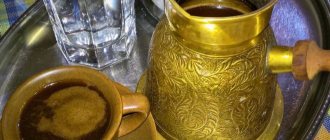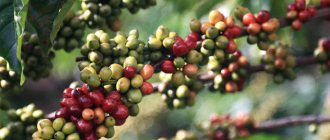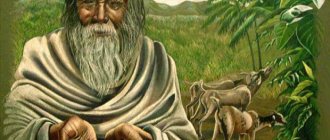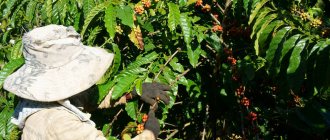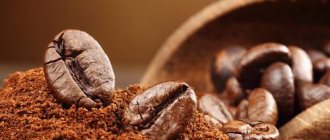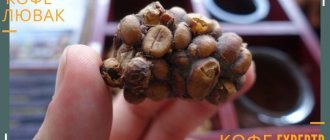The birthplace of coffee is ancient Ethiopia.
Ethiopia is one of the main coffee producers in the world and on the African continent.
Coffee trees are far from uncommon in different countries, but they appeared there not so long ago. The plants that produce the bitter, aromatic Arabica beans originate in ancient Ethiopia. It was here that the trees from which all the varieties originated were first discovered.
It will come as a surprise to Robusta lovers that their favorite drink comes from Africa. The Congolese coffee tree is native to the grassy banks of the Congo River.
Interestingly, the coffee drink was first prepared not in Africa, but in ancient Arabia. Africans simply used bitter grains as a spice in cooking.
Most are grown in Brazil (about 3 million tons per year), Vietnam (about 1.8 million tons), Colombia (800 thousand tons). Where coffee beans are planted in special nurseries, providing sufficient lighting and climatic conditions. After six months, seedlings are sent to pre-fertilized fields. The first fruiting begins after two years. Coffee beans are collected by hand, with the participation of seasonal workers.
Coffee arithmetic
Scientists have found 800 different aromatic compounds in coffee. It is not surprising that this drink has a lot of fans - among several hundred aromas, everyone can catch the one that particularly excites them.
500 billion servings of coffee are consumed by the world's inhabitants every year.
Every resident of Finland accounts for 12 kg of coffee per year - in this country they love the invigorating drink like nowhere else in the world (an adult drinks 5 cups a day on average).
The tastes of coffee lovers are distributed as follows: 70 percent of the world’s inhabitants prefer Arabica, 30 percent prefer Robusta.
Does the presence of caffeine in a particular variety play a role here? Probably yes. Arabica is “harmless”, containing 1 percent, Robusta – 2 percent caffeine. What else are the differences between Arabica and Robusta we discussed in this article.
Americans who love to surprise the world set an unusual record in 2010 - they made a huge cup that could hold 35 thousand servings of coffee.
In Italy, the barista profession is one of the highest paid. Find out who a barista is here.
The first coffee shop in history opened in 1500
The first information about the coffee drink dates back to the 1000s AD.
The discoverers of invigorating nectar were the Arabs; it was they who brought grains from Africa and began to grow them on the Arabian Peninsula. The drink bore little resemblance to everyone’s usual coffee – cinnamon and crushed ginger coffee were added to the aromatic liquid. From the Arabian Peninsula, the coffee tree came to the Ottoman Empire. It was not until the 16th century that traders began transporting grains by sea to Europe.
It is said that the first coffee shop was opened in 1554 in the Tahtakale region by Halepli Hakem and Surieli Shems
The first coffee shop was opened in Turkey around 1500. Coffee appeared in England much later - around 1600. For a long time, only men were allowed to drink the invigorating liquid.
Bitter beans arrived in France in the 1700s; in Russia, the appearance of coffee occurred under Tsar Peter the Great. According to historians, the drink did not gain much popularity in the country. Tsar Peter had to open special coffee shops and almost force people to drink “bitter drink,” which is what his subjects called the aromatic liquid.
Interesting facts about coffee history
So, over 800 years ago, people began to consume coffee beans in order to cheer up. From century to century, the forms and traditions of drinking coffee changed, and each country developed its own attitude towards the drink. This is how the world coffee culture was formed.
- Coffee beans did not immediately turn into a drink. The berries were first chewed, then a kind of tea was brewed from them. Arab warriors or travelers mixed dried and crushed fruits with fat along with grains. Such energy cakes helped them maintain strength during the hike.
- The Arab world has been preparing coffee in special jugs for a long time. The dishes were called dalla and were in use among both pilgrims and townspeople. Although, why was it? In many Arabic coffee shops, even today you will be served a drink in a tall jug with a whimsically curved spout.
- The cezve we are familiar with was invented at the court of one of the Arab rulers. He loved coffee very much, but had problems preparing it. The simple dalla was definitely not suitable for luxurious quarters, and the coffee was running out of the golden saucepan. So one wise man, who served no less than a vizier, had to take the decision upon himself. He came up with the shape of the cezve, and as a result of experiments, he was convinced that only copper or silver was suitable as a material.
- In the Arab world, attitudes towards drinking coffee changed, from complete rejection to full approval. During one of the periods when the authorities were favorable to the drink, merchants, for advertising purposes, promised paradise to everyone who drank coffee. After all, wine, according to Muslim traditions, was prohibited, and the infusion of coffee beans perfectly invigorated and toned, completely consistent with the spirit and letter of the law. Eventually, coffee established itself as a healthy, legal, and even approved product.
- Over time, the drink took an important place in human life. The reason for divorce in a medieval Turkish family was the wife’s complaint that her husband was unable to provide her with the necessary amount of coffee.
- In Europe, the drink was long considered inappropriate for Christians, as it was consumed by Muslims. We owe the absolution of coffee to Pope Clement VIII. It was he who was impressed by the taste and aroma, as well as the invigorating properties of the drink, and blessed its use.
- The first European coffee house appeared in Great Britain, in Oxford, in 1637.
- The spread of establishments where you could drink a cup of coffee in mainland Europe began in Venice. There, in 1654, the first establishment open to everyone opened.
- The main visitors to public places where coffee was served were university students and teachers, artists, writers, freethinkers of all stripes. It is therefore not surprising that these institutions quickly became centers of intellectual life and free thought.
- In 1675, Charles 11 closed the coffee houses of England as a gathering place for enemies of royal power. Subsequent events confirmed the rightness of the monarch. The French Revolution of 1789 also owes its flame to the conspirators who hatched their plans in Parisian coffee houses.
- Many monarchs imposed coffee bans. For example, in Germany, not only public institutions fell under royal disfavor, but also coffee itself. In 1777, Frederick the Great banned the use of the drink, imposed huge fines on lovers and even established a special supervisory body - a coffee investigation. His main task was to find those who drink coffee and punish them severely, including confiscation of property.
- Americans became acquainted with coffee on a massive scale in 1670, when the first coffee shops appeared on the continent. Before this, the most popular breakfast drink among North Americans was beer.
Coffee has many faces and many facets, it is different for everyone. Share with us your coffee story – romantic, funny, unusual, or maybe dramatic?
The name of coffee was given by the Arabs
The origin of the ancient name “coffee” entered the English language in 1598 from the Dutch word “koffie”.
Historians do not have a single opinion on where the name coffee came from. There are several versions, the most popular and quite plausible is associated with the nomadic Arabs. “Kava” translated from Arabic means “invigorating”, “giving strength”. It was this drink that nomads used to invigorate themselves during long marches. The name was preserved, but in Western European countries the drink began to be called “cafe” or “cafe”.
Another version is associated with the province of Kafa. It was here that trees were first grown for industrial purposes and named after their country. The name has been preserved, but has been slightly transformed.
There are four main types of coffee, not two.
Arabica, Robusta, Liberica and Excelsa: four types of coffee that grow on the globe
There are four varieties of coffee trees in the world. The most common is Arabica (Arabic coffee). It occupies about 70% of the world market and is considered a leader. It has a rich coarse aroma, a pleasant strong taste with bitterness. Often used to prepare coffee blends or instant granules.
Robusta is another variety of coffee trees, significantly inferior in production to Arabica. It has a sour aroma, refined taste, and slight sweetness. Used in pure form or in mixtures with Arabica.
The most popular Arabica coffee has a rich, bright aroma and a pleasant, strong taste with a hint of bitterness.
Two more types of varieties, less known, are Excelsa and Liberica. They have much in common with Robusta, but are significantly inferior in taste. They are used to give the drink strength and lasting aroma.
The first coffee was prepared at about 10 o'clock
Ancient peoples infused coffee for 5-8 hours.
In ancient times, coffee was prepared according to a simple recipe, which was used only for medicinal purposes. Whole unrefined grains, previously dried under the hot rays of the sun, were poured with water, sent to an open fire, boiled or simmered for half an hour. Be sure to insist for 5-8 hours.
Spices were added to the coffee (cardamom, ginger, cinnamon powder). The prepared infusion resembled ordinary green tea in tone and did not have much strength.
Drying and roasting of coffee beans began only in the 7th century
A few decades later, they came up with the idea of cleaning the grains, frying them over an open fire and pre-grinding them. The principle of creating the drink did not change - the coffee mass was poured with water, boiled and infused. The only difference is that the liquid was more aromatic and strong, and acquired a dark tint.
They drank coffee hot or cold and added sweet ingredients (sugar, honey). The poor segments of the population did without sweets, drinking only bitter liquid, often from poorly refined grains.
Traditions of use
Coffee was not always consumed the way we do today. Arab warriors, for example, took on a campaign a kind of “energy” cake, which included coffee beans.
But even after becoming a drink, coffee has not lost its national flavor.
Bedouins brew coffee with cardamom and ginger, it turns yellow in color. The French were the first to add milk to coffee.
In Ecuador, the drink is brewed very strong and sugar is added. Placed in the refrigerator, it thickens; before use, it is diluted with boiling water.
Belgians prefer to enjoy coffee while snacking on chocolate. In Morocco, coffee is seasoned with pepper, and in Ireland they add whiskey (read more about Irish coffee here).
The Vietnamese prefer the drink chilled, almost ice-cold, and very strong.
The structure of the coffee berry includes four layers
Usually there are two grains in a coffee berry, but sometimes during pollination only one develops.
A coffee berry, regardless of the type of tree, consists of four layers in structure. The upper part is a silvery thin skin covering the grain. During frying, the film turns into a fragile husk, which easily lags behind the walls of the main part.
The parchment shell is the next layer of the berry, quite hard and dense. The purpose of the patch is to protect the interior from damage and temperature changes. Peeling of the parchment shell is usually carried out before transporting the grains to protect the goods from loss or damage.
Another layer of the berry is gluten, which has a high percentage of sugar content. The adhesive shell is often confused with the core. Gluten is not removed when grains are cleaned - the sweetness or bitterness of the drink depends on the quantity. The core of the berry is the pulp. It is this part that is used in making traditional coffee.
Coffee is a real cornucopia of nutrients. The berries contain:
- vitamins (B1, B6, PP);
- caffeine;
- tannins;
- carbohydrates;
- minerals (potassium, iron, zinc, calcium);
- proteins.
It is believed that the higher the coffee tree grows, the more aromatic the drink is obtained from its beans. The
beans also contain a high percentage of acids, which, when heat treated, provide the drink with a persistent strong aroma.
Useful facts
In 2003, pharmacists from Naples sued coffee! The reason was the allegedly negative impact of aromatic drinks on the nervous system. The lawyer cited numerous facts proving the positive effects of caffeine on the body. The accused was completely acquitted.
Caffeine stimulates brain activity by increasing the production of dopamine. This “hormone of happiness” is not only responsible for high spirits, but also motivates creativity. Coffee also, by blocking the inhibitory neurotransmitter adenosine, gives a boost of energy and improves concentration.
The daily dose of caffeine should not exceed 400 mg per day. To prevent the miracle drink from turning into poison, limit yourself to 2-4 servings.
Coffee rejuvenates. Among the active substances contained in grains, polyphenols and hydrocinnamic acid take pride of place - powerful antioxidants that neutralize free radicals. These “elixirs of immortality” remove toxins, prevent tissue damage, protect against aggressive ultraviolet radiation and slow down aging.
Caffeine reduces the risk of heart attack. This fact was proven by scientists at the Harvard School of Public Health. According to studies, people who drink 2-3 cups of coffee daily suffer from cardiovascular diseases almost 3 times less than fans of other drinks.
7. The traditional method of cooking was invented by the Arabs
First, high-quality green grains were fried until brown.
Many recipes for preparing an aromatic drink have been preserved by the Arabs. The process of brewing coffee turned into a real action, which is why it took at least an hour. Only high-quality grains were used, always green.
Clay cups were filled one third with green grains and covered with hot coal from fruit trees. The next step is frying until brown. Each grain was taken out and carefully examined - if burnt or undercooked areas were found, the raw material was thrown away.
After brewing in a Turk, the coffee was poured into small cups and immediately served to the table.
The roasted grains were ground using wooden mortars into a fine powder resembling dust. The required amount of coffee was poured into the Turk with cold water and placed on low heat - the drink should not boil, but simmer slightly. The prepared aromatic liquid was poured into a large clay container, infused a little, poured into small cups, and immediately served to the table.
The first interesting legend associated with coffee
The properties of coffee were first discovered by the Ethiopian shepherd Kaldi, who noticed that his goats became energetic after eating berries from an unfamiliar tree.
There are many legends associated with the coffee drink. One of the most interesting is related to the discovery of coffee. According to legend, we have goats to thank for the invigorating drink; it was they who helped discover the properties of berries from coffee trees. One day, a shepherd grazing animals in a coffee grove noticed that the goats were happily chewing the leaves and red fruits of the tree.
At night, the shepherd was in for a surprise - the goats didn’t even think about going to bed, they moved briskly and showed no signs of fatigue. The frightened man shared his observations with the abbot of the monastery, located not far from the pasture.
The monastery decided to take advantage of the discovered qualities of coffee - an infusion prepared from the berries was given to the monks, who had to stand nights in prayer. Only many years later did the clergy learn to roast the grains, grind them and prepare invigorating nectar.
Where did coffee come from?
There is a legend that goats were the discoverers of coffee. An Ethiopian shepherd who lived in the 9th century noticed that after eating unknown dark red berries, his four-legged charges became extremely energetic and playful. The puzzled peasant took the fruits to the monks, who prepared an invigorating decoction, which today ranks second in the ranking of the most popular goods in the world.
Until the middle of the 16th century, savoring the wonderful nectar was the prerogative of the inhabitants of the East. Europe learned about coffee in 1615, when Venetian merchants first brought brown beans to Italy. The attitude towards the unprecedented bitter liquid was ambiguous. The priests called it a Muslim potion, blackening the blood of Christians. Pope Clement VIII defended coffee, saying: “This drink is so delicious that it would be a pity to leave it to unbelievers.”
Among the amazing facts about coffee, there are prohibitions on its consumption. Thus, in 1623, the Ottoman Sultan Murad IV introduced severe penalties for drinking the drink. And 154 years later, the ruler of Prussia, Frederick the Great, issued a manifesto on the superiority of beer over the brown elixir. According to the decree, the inhabitants of the kingdom must start the morning with a good mug of foam.
On the plantations, each worker collects up to 700 kg of grains per day
Coffee beans are collected only by hand.
It is often mistakenly believed that coffee berries grow on bushes. Valuable plant materials used to prepare an invigorating liquid are collected from trees. Plants can grow up to ten meters and develop a gorgeous, huge crown. It is difficult to collect berries from large trees; special equipment is required, so already 3-4 years after planting the seedlings, pruning begins. The optimal plant height is 3-4 meters.
Collection is carried out only by hand. The beans are sent into large wicker baskets that can hold about 100 kg of raw materials. One worker can collect up to 7 such baskets per day. The payment for the work is quite high - 8-10 dollars for one braid.
You can harvest up to 1.5 thousand berries per year from one mature coffee tree.
The age of coffee trees is up to 70 years. The largest number of fruits are harvested in the first ten years after the start of fruiting. Every year the plants produce fewer and fewer grains, so it is not advisable to keep the trees for a long time - 20-25 years after planting they are uprooted, the soil is fertilized and young seedlings are planted.
2. It is drunk in dozens of different countries, morning and evening, at lunch and at breakfast. And how many of its varieties have been bred at present is impossible to count!
3. The usual drink from roasted grains crushed into powder began to be prepared only in the 13th century. At the same time, they began to add cinnamon, vanilla and milk to coffee.
4. Don't forget that you shouldn't drink too much coffee - it can be harmful to your health.
5. Coffee was discovered around 850 AD, but its real popularity came only a few centuries later.
6. The most common type of coffee is Arabica (69% of world production), followed closely by Robusta (29%), and the remaining varieties account for only 2% of world coffee production.
7. In Italy, coffee was first discovered in 1615, and in 1720 in the city of Venice, on St. Mark’s Square, the world-famous Florian cafe opened, which was visited by Goethe, Casanova and Rubinstein, and the Guardi cafe, which was visited by Liszt and Byron.
8. In Uganda, green coffee beans are usually mixed with spices and sweet grass, dried and hung in bags around the house as decoration and a talisman.
9. Coffee does not contribute to dehydration. Caffeine has long been blamed for its diuretic properties, but this is actually not true. As long as you don't drink coffee in large quantities (more than 500 to 600 milligrams per day, or two cups), there won't be any negative effects.
10. The first coffee shop in Paris opened in 1689 and was called Procope. Its owner was lemonade merchant Francois Procope. It was located opposite the theater, and its main visitors were representatives of bohemia - artists and painters.
11. The main coffee producer on Earth is Brazil. It is interesting that workers of Brazilian plantations collect not only ripe berries, but all fruits without exception. Sometimes they use a pneumatic device to shake the branches of the coffee trees so that the berries fall to the ground.
12. Italians drink coffee with sugar, Mexicans - with cinnamon, Germans and Swiss - with hot chocolate, Belgians - with chocolate. Ethiopians add salt to their coffee, and Moroccans add pepper.
13. In the Middle East, cardamom or other spices are often added to coffee. Austrians drink coffee with whipped cream. Egyptians prefer “pure” strong coffee, adding sugar, milk, cream, and cardamom if desired.
14. Coffee contains important nutrients needed for survival. One cup of coffee contains 11% of the daily recommended intake of riboflavin (vitamin B2), 6% pantothenic acid (vitamin B5), 3% manganese and potassium, and 2% niacin and magnesium.
15. In Russia, coffee has long been considered more of a medicine than a tasty drink - it was used to treat migraines and a number of other diseases.
16. The height of the coffee tree is a little more than 9 meters. But since it is more convenient to collect fruits from lower trees, now the height of coffee trees rarely exceeds 3 meters.
17. The coffee genus consists of approximately 90 plant species, but only two of them are used on an industrial scale.
18. In those countries where coffee grows, it is still collected by hand. An experienced picker can harvest up to 7 baskets of beans per day, each weighing up to 100 kilograms. Payment for this work ranges from $2 to $10 per basket. After the beans are dried and roasted, the price of the basket increases to $110.
19. Instant coffee was invented in 1906 by a Belgian named George Washington.
20. Coffee lovers visit the dentist much less often. The elements contained in this drink prevent bacteria from settling on tooth enamel.
21. Espresso does not have as much caffeine as drip coffee. Espresso is prepared quickly by passing water under high pressure through the ground beans. Since this reduces the contact between water and coffee, there will be less caffeine in the Espresso cup.
22. If you drink 4 cups of coffee a day every day, this can minimize the risk of gallstones and cirrhosis of the liver. Moreover, coffee drinkers have a 60% reduced chance of developing Parkinson's or Alzheimer's disease.
23. In 1675, the British monarch Charles II closed all the "coffee houses" in England because he believed that citizens opposed to him were gathering there. The king's example was repeatedly followed by other world monarchs.
24. Caffeine is a substance banned by the International Olympic Committee. If, during testing, more than 12 micrograms of caffeine per liter is detected in an athlete’s urine, he will be removed from the competition.
25. Studies have shown that diuresis does not change significantly when a person drinks caffeinated drinks. So as long as you enjoy coffee in moderation, there is little cause for concern.
26. Coffee was discovered thanks to Ethiopian goats. According to legend, Ethiopian shepherds were the first to drink coffee after seeing how goats behaved and chewed the berries of this plant with pleasure.
27. Caffeine begins to act very quickly. It only takes about 10 minutes from the first sip until the caffeine begins to take effect.
28. The first coffee shop in Vienna was opened by the Pole Kolzycki. He was a real coffee fan and managed to save more than one bag of coffee beans when the Turks leaving the city set it on fire. It was thanks to the Turks that the Austrians already in 1683 learned how to truly cheer up.
29. Caffeine enhances the effect of aspirin and paracetamol. After a cup of coffee, acidity increases, and the stomach accepts and dissolves painkillers more readily.
30. Coffee consumption is greatest in Finland, where adults consume an average of five cups of coffee per day.
31. Caffeine improves performance in sports. Caffeine increases your adrenaline levels and releases fatty acids from fat tissue, leading to better results in those who drink coffee before exercise.
32. A coffee tree grows and bears fruit for about 60-70 years, and up to one and a half thousand berries can be collected from one tree per year.
33. 70% of coffee lovers drink Arabica, which has a pleasant, mild taste, and 30% drink Robusta, which has a bitter taste and contains half as much caffeine.
34. “Robusta” is a lower class variety, but it is more resistant to drought, disease, and you can harvest twice as much from it.
35. Arabica contains about 1% caffeine, Robusta – 2%. Manufacturers of instant coffee mainly mix Robusta and Arabica.
36. Coffee is good for your liver. People who drink four cups of coffee a day are 80% less likely to develop cirrhosis of the liver.
37. Coffee is a berry bean that is red, yellow or green in color.
38. A cup of black coffee without sugar has 0 calories.
39. Green (unroasted) beans can last up to a year in a cool, dry place without losing much of their flavor. After coffee beans are roasted, their properties begin to disappear after about two days.
40. Caffeine is actually crystals. The entire effect of coffee is caused by tiny 0.0016-inch caffeine crystals entering your body. So small, but that's how they work.
41. The most expensive coffee in the world is made from elephant dung, and it is called Black Ivory. It costs $50 for one cup. To get 1 kilogram of this type of coffee, you need to feed 33 kilograms of fresh coffee berries to an elephant. After they are digested, the wives of the elephant mahouts collect the dung, knead it and extract coffee from it.
42. Previously, Turkish grooms made a promise during the betrothal ceremony that their wives would certainly be provided with coffee, and failure to fulfill the vow could cause divorce.
43. One cup of coffee contains 300 antioxidants that will stay in the body for a month.
44. Coffee became an everyday drink in Russia only thanks to the efforts of Peter the Great, who forced his entourage to drink “bittersweet.”
45. Coffee will help you live longer and healthier. Coffee contains many antioxidants (it is the largest source of antioxidants in the average Westerner's diet!). This helps in the fight against so-called free radicals, which cause many serious diseases. As a result, coffee drinkers are less likely to develop diseases such as Parkinson's disease, diabetes and heart disease.
46. In Bedouin homes, coffee is usually prepared with ginger or cardamom, which results in a yellow color and a very pleasant taste. At the same time, according to tradition, it is served to the guest with the words “My home is your home.”
47. October 1 is “Coffee Day” in Japan. This country ranks third in the world in terms of coffee consumption per person.
48. Decaffeinated coffee appeared by accident - a ship with coffee beans almost sank during a storm, and its hold filled with water. The owner of the cargo was in despair, but still decided to take the grains to a specialist and make sure that they were unsuitable for sale. To his surprise, the beans were fine, only they had lost almost all of their caffeine during their stay in the water.
49. Coffee ranks second in the world ranking of the most sold goods. In the first position is oil.
50. Coffee is grown in a strictly defined area called the coffee belt of the planet. The coffee belt unites all regions that have the conditions necessary for coffee to grow. Since this plant requires a lot of sunlight and heat, all these areas are located near the equator.
photo from the Internet
Bach and Voltaire were coffee lovers
Voltaire lived to the age of 84, despite the fact that the doctor promised the philosopher an early death due to his passion for coffee.
History says that many famous personalities preferred coffee to other drinks. One of them is the French philosopher Voltaire, who believed that it was to aromatic nectar that he owed outstanding achievements. Voltaire drank up to 50 cups of the drink per day; most of the money he earned was spent on such a hobby, so the heirs were left with only minor savings.
Johann Sebastian Bach was also considered a real coffee gourmet, fond of drinking the invigorating liquid. The composer was slightly inferior in the amount of coffee consumed to the philosopher Voltaire - 15-20 cups of strong drink were enough for the great musician per day. In the 1700s, Bach created the famous Coffee Cantata, dedicated to bitter nectar. The work has humorous notes - it glorifies the necessity for the human body and some dependence on coffee.
Interesting facts from history
There are indeed many unexpected moments in the history of coffee. In many ways, these are curiosities and conjectures, but there are also some scientifically proven hypotheses.
Kopi Luwak is one of the most expensive drinks in the world
Below is a selection that includes the most interesting facts about coffee from history:
- The coffee bean was originally viewed as a food rather than a beverage product. The grains were dried, rolled in fat and taken with them on long journeys as a product that helped maintain strength. They simply chewed it carefully and for a long time.
- The most expensive coffee in history is produced using elephant dung. It's called Black Ivory and costs almost $50 per cup.
- Each adult consumes about 70 cups of coffee per year on average, so this product is in second place in demand after oil. The most drinking nation is the French, followed by the Swiss and Germans. They drink an average of 150 to 200 cups of the drink per year.
- Coffee is the drink of geniuses. Many famous scientists, philosophers, and musicians were especially attached to this drink, considering it a source of inspiration. So, Beethoven had his own recipe; he prepared a drink from 60 grains per cup. The strongest espresso today will seem like water compared to this drink. And for Balzac it was completely common to drink 60 cups of coffee a day. You could say he drank it continuously while he was awake.
- Coffee once became a participant in a lawsuit. He was accused of distracting office workers from their activities due to frequent coffee breaks. However, the product was vindicated by Italian lawyers, who collected evidence that coffee increases productivity by stimulating brain activity, increasing blood circulation and tonic properties.
- Legend has it that all the coffee trees growing today outside the Muslim world are descendants of seven bushes that were grown by a pilgrim from India, Baba Budan, who stole 7 beans in Mecca and planted them in his homeland.
- Riot over coffee. It was the ban on the use of the drink by ordinary people in Prussia in 1785 that became the reason for mass discontent.
- The smell of coffee is the most recognizable in the world.
- The first coffee house (manufactory) was opened in Istanbul in 1475.
- The quality of a drink is largely determined by a person’s smell receptors, which recognize only the power of aroma as a formative factor.
The coffee tree loves to grow on volcanic soil, and it gives its first harvest only after 5 years, and lives on average 25 years. During the flowering period, it shines with 30 thousand snow-white flowers, which within a day turn into fruits.
Coffee is the drink of happy people, making their positive emotions even brighter.
Coffee has its own holidays
In Costa Rica, a coffee festival is held annually on September 12, with bright, masquerade, theatrical performances.
Many countries in which coffee is a traditional drink celebrate the holiday of this invigorating aromatic nectar. In Costa Rica, the celebration occurs in September. On the 12th, colorful festivals and fairs take place; cafes and restaurants offer all kinds of drinks with the main ingredient – coffee beans. At night, a fantastic action begins - fireworks, theatrical performances, masquerades.
Ireland is another country where coffee is revered so much that they decided to make it a holiday. September 19 is the day when most of the country's residents go to the streets to enjoy a cup of aromatic nectar with friends, acquaintances, and just passers-by. Many families have a tradition of gathering around the festive table; every home has a traditional recipe for making coffee, passed down from generation to generation.
Coffee traditions of Italy
Since Italians are famous for their reverent attitude towards everything related to food, they have their own special traditions regarding coffee drinking.
It is appropriate to order cappuccino, latte and similar types of drinks only in the morning. By ordering them for dinner, you can make those present laugh until they cry.- The word “espresso” is taboo here, because it is akin to a technical term. It’s better to just say caffe, they will understand you.
- In Italy, double servings are considered a sign of bad taste. People here like to drink coffee often, but in small doses.
- Coffee is never paid for in advance. The only exception may be an airport or other exclusively tourist establishment.
- The drink is served warm. To make it hot, this must be mentioned when ordering. And it will be very un-Italian.
- Italians drink coffee while standing, because this is how, in their opinion, it is better absorbed.
- Violation of any of the listed traditions, according to the residents of the country, is terrible!
The drink is not recommended for athletes
It is better for professional athletes to stop drinking coffee so as not to harm their career.
Coffee is a drink that is not welcome in sports. Doctors warn that abuse leads to health problems. Even a small amount of caffeine is undesirable if a person is involved in intense sports - the International Olympic Committee has put the substance on a par with cocaine and steroids.
Drinking about five cups of hard liquor by an Olympic athlete will result in disqualification. This amount of coffee increases the level of caffeine in the body, which is considered an attempt to increase energy and endurance, reduce sensitivity to injury, and gain an advantage in a fight or singles performance.
Desserts are made from coffee berries
Coffee beans are widely used in preparing and decorating desserts.
Despite the fact that coffee is considered a drink, many people prefer to consume dry roasted beans. Some companies have turned this taste craze to their own benefit - flour is prepared from coffee residues, used for making sweets, desserts, and baking bread.
Flavorings are often added to such baked goods. Sweets with the aroma of fruits, berries and the taste of coffee are a gourmet dish, especially if served with a cup of an invigorating drink with milk or cream.
About processing coffee beans
Do you get confused when you hear “washed Columbia”? It's about the way coffee is processed. Now we'll explain everything. The fruits have been collected, now we need to somehow extract coffee beans from them. There are two technologies for processing coffee - washed (in English “washed”) and natural (denoted as “natural” or “dry”). The way the grain is processed affects the taste and aroma of the final product.
The natural or dry method involves drying the berries directly on the ground. This is often done on concrete slabs. The highlight of the method is this: after long contact with the sweet berry, the grain acquires density, pronounced sweetness, and rich taste. In the taste of coffee processed using natural technology, you can hear caramel, nutty, chocolate shades, even notes of baking. However, drying it this way sometimes results in a slight earthy flavor, which isn't everyone's cup of tea.
Washed processing is usually rated higher. With this method, the grains are first peeled and then loaded into a tank of water. The coffee bean is kept in water until the gluten is separated. Washed coffee has a pronounced acidity and is characterized by notes of berries and citrus in its taste. The drink is not as rich as from naturally dried beans, but it is softer. Here, of course, whatever suits your tastes best.
Fun fact for dessert. While you were reading our text, you didn’t think about it, what about the berries, are they really not used in any way? Are used. Usually the fruit pulp is used as fertilizer. But sometimes an original drink, cascara, is prepared from dried berries. Cascara tastes nothing like coffee, more like compote or fruit drink. Moreover, it also contains caffeine.
You can appreciate the taste of cascara yourself if you order this drink in our online store. In addition to cascara, the Bean&Roast catalog includes coffee from all famous regions. Both processing methods are presented – washed and natural.
Coffee made from feces is not for everyone
Grains fermented by the animal's digestive system to suit everyone's taste.
and not many people can afford Kopi Luwak - coffee that has undergone long-term processing, not thermal, but natural. The grains are fermented by the digestive system of an animal similar to the common house cat, the civet cat.
The animal feeds only on coffee berries, which pass through the digestive tract. The grains do not split and are not digested - the berries are collected along with the droppings, cleaned, and washed. The final stage of processing is drying.
Naturally processed coffee is quite expensive - about one and a half thousand dollars per kilogram. The drink is not for everyone - it has a specific taste, with some oiliness.
The elite and expensive variety of coffee “Black Tusk” is fermented in the stomach of an elephant
Competition Kopi Luwaku - grains that have been fermented in the stomach of an elephant. “Black Tusk” is an elite coffee variety. After elephants eat plant material, the feces are thoroughly washed, the berries are soaked for several hours and washed. The taste of the drink is reminiscent of tea - there is no specific bitterness, notes of expensive tobacco, dates, and cocoa are felt in the aroma. The cost of a sachet is 35 g. – 80-90 dollars.
Coffee made from... poop
Divine, elite, prestigious, with a large number of noble epithets and the most expensive in the world today - Luwak coffee is extracted from musang dung. This cute little animal with sad eyes is a necessary link in the chain to obtain the “drink of the gods.” And all thanks to his love for coffee beans and special enzymes, under the influence of which these beans, which naturally leave the digestive tract of the animal, acquire their delicious deep taste. The owner of the farm can only pick out the golden product from the musang excrement and sell it to coffee gourmets at an incredible price.
Benefit for health
Coffee in moderation reduces the risk of heart disease and cancer
Regardless of the variety, coffee in moderation is considered healthy, but only if there are no contraindications. The aromatic liquid reduces the risk of developing heart disease and oncology. Some substances contained in the drink improve the functioning of internal organs and systems and have rejuvenating properties.
Regular consumption of coffee (no more than three cups per day) maintains blood sugar levels and prevents the development of diabetes. The drink also has a beneficial effect on the skin and hair - it improves color, structure, and protects against external negative factors.
Five shades of black
Doctors have their own gradation of coffee drinks based on harmfulness. As the benefit decreases, it looks simplified like this.
- Cappuccino. It comes first if consumed traditionally without sugar and with cinnamon, which improves metabolism.
- Espresso. 1-2 cups a day will help the brain work. But add sugar, and espresso can be relegated to last place.
- Americano. It’s good for its moderation, but dangerous with the risk of not calculating the amount due to its weak strength and overdoing it with caffeine.
- Latte. For a richer taste, it is cooked with whole milk, or even cream. The result is 8g of fat per serving. And if you add sweet syrup...
- Mochaccino-chocolata. If it weren’t for the imitation of chocolate taste with all kinds of flavorings instead of real cocoa beans and a large amount of sugar, it could have topped the table. But, alas.
Help of coffee in treatment
Coffee protects muscles and promotes the restoration of heart cells even after a heart attack.
Numerous studies of berries have proven that plant materials contain elements that can improve health and promote healing! The effectiveness of the therapy prescribed by your doctor can be easily increased with several cups of drink a day.
Coffee contains substances that increase acidity in the stomach. Thanks to this quality, medications are quickly broken down and absorbed into the walls of the digestive tract, beginning to work much more efficiently. The main thing is not to self-medicate - some medications do not combine with caffeine. It is better to first consult with a specialist. Another prohibition is not to take the tablets with coffee. Consume your favorite nectar an hour and a half after taking medications.
What can coffee do?
- Kill. Doctors call a lethal dose 80-100 cups in one day.
- Treat. Studies conducted independently have shown that drinking several cups (up to 5) a day reduces the risk of intestinal and liver cancer, heart attack, diabetes and Parkinson's disease, and also postpones an unwanted encounter with “old man Alzheimer’s.”
- Increase libido in women. With one caveat - we are talking about irregular use, from time to time.
- Reduce pain during prolonged muscle activity or stiff muscles from prolonged immobility.
- Ease hangover. The reason is its ability to block acetaldehyde, preventing it from being converted to acetate under the influence of ethanol, which is usually the cause of hangover migraines. However, the method itself is not harmless to the body.
- Disrupt the body's cycadal rhythms. Because of this, you may indeed not receive signals about the desire to sleep and stay awake at night, but the body does not immediately return to order after this.
17. National ancient currency - coffee berries
In countries where coffee is grown and produced for hundreds of years, coffee beans are considered almost an analogue of national currency.
Many ancient states used coffee fruits as money. To distinguish the different denominations of the berries, they were painted in bright colors, each of which had its own value. The paints used were natural, durable - once painted grain retained its color for many years.
Prosperity was demonstrated in an interesting way - the most expensive berries were used to make necklaces with which the richest people adorned themselves. Thieves often took advantage of this; there were even entire gangs that specialized in stealing coffee jewelry.
Historical excursion
There are several hypotheses about how people first realized the existence of coffee and its beneficial properties.
Here are two stories that happened in Ethiopia so long ago that it is impossible to verify their authenticity today. Here, believe it or not, believe it or not.
One of the stories is about a shepherd named Koldi. He discovered that goats happily pluck berries from trees, and after eating them, they then stay awake all night.
The shepherd was an inquisitive man and decided to experiment - he tried these berries himself and also could not sleep until the morning. Thus, the main secret of coffee was revealed, which the shepherd shared with his fellow villagers.
The second story is related to forest fires that raged near the Ethiopian city of Kaffa.
One of them destroyed almost all the trees, leaving behind charred trunks and branches with fried grains.
Surprisingly, instead of the disgusting smell of burning and soot that accompanies fires, the residents of a nearby village this time felt a pleasant aroma.
Having gone to look at the consequences of the disaster, they discovered its source: the berries on coffee trees, which had previously been considered absolutely useless, smelled so magical. It is not surprising that they found use almost immediately.
And here are the events (no longer legends!) that took place around coffee in subsequent history:
- In England, by royal decree of 1675, the so-called “coffee houses” were closed, since the citizens who gathered there over a mug of coffee were planning to protest against the legitimate government.
- The first coffee shop in Paris was opened in 1689 by a lemonade seller named François Procope. He hoped to attract local bohemians as visitors (the coffee shop was located opposite the theater). And so it happened: the nice establishment was chosen by actors, musicians, and artists.
- In Russia, coffee first appeared as a medicine. Alexei Mikhailovich, the second tsar of the Romanov dynasty, father of Peter I, used this drink for a runny nose, loss of strength, and headaches.
- Among the visitors to the Venetian cafes “Florian” and “Guardi”, opened in 1615 and 1720, were such famous personalities as Goethe, Liszt, and Byron.
- The reason for popular unrest in Prussia in 1785 was the ban on the consumption of coffee by ordinary people.
- In many European countries, coffee was considered a drink for Muslims, which Christians should not drink.
- Coffee once saved two twin brothers from death row. The Swedish king Gustav III allowed the execution of the sentence to be delayed for the sake of a scientific experiment: one of the brothers was given coffee and the other tea to determine which drink was more harmful. As a result, the test subjects outlived both Gustav III himself and the doctors - one of the brothers died of natural causes at 83, and the second even later. The end to the scientific dispute was never reached.
- A custom, funny from a modern point of view, existed in Turkey - the groom swore an oath that he would provide his wife with coffee for the rest of her life, otherwise the marriage would end in divorce.
- In England, women turned to the authorities with a demand to ban coffee (the petition read “sickening water”), since this drink, or rather spending time in coffee establishments, distracted their spouses from the family hearth.
- The first chess tournaments in a number of countries began to be held in coffee establishments.
- In 1790, the first advertisement for coffee appeared in one of the American newspapers, paid for by coffee powder manufacturers.
The situation was successfully resolved with the help of Pope Clement VIII: he liked this drink so much that he blessed its use.
Here are some interesting facts from modern history:
- coffee ranks second (after oil) in global sales;
- In Italy, the price of espresso is controlled by the government, giving this product important national significance.
Coffee – amulet and talisman
Enchanted bitter seeds are reliable protection for a newborn child, they believe in Uganda.
Uganda is the country that founded one interesting belief. Residents of the country believe that coffee berries can protect against the evil eye, damage, and ill-wishers. The main thing in the amulet is to combine the components correctly. In addition to coffee, spices and sweet herbs are used. Bitter grains are mixed with other ingredients, sewn into small linen bags, and dried for several weeks in direct sunlight. Fragrant amulets hung around the house are reliable protection that applies to all residents.
Coffee berries are also used to make amulets for newborns. In Uganda, it is believed that a born baby does not have a patron, so parents have to take on the role of his protector from ill-wishers. Enchanted bitter seeds are a reliable shield for a child, protecting him from the evil eye.
Unusual uses
A person is always not enough of the hints that nature gives him; he begins to figure out how else to manage her gifts.
In Uganda, green coffee beans are used to make unique talismans by mixing the beans with herbs and spices. Bags with the “magic set” are hung throughout the house.
In the small British town of Banbury, a power plant operates on coffee grounds, and in addition, it is used for guessing, as is, however, customary in many countries around the world.
Greek young ladies have used coffee to implement a rather funny way to “send off” an unwanted suitor - they treat him to coffee without foam. The girl offers the one who is attractive a cup with an appetizing thick “cap”.
In Japan, they came up with baths (or rather, swimming pools) with coffee - they give the bather strength and health.
Cosmetologists around the world prepare scrubs, masks, and self-tanning products from coffee beans. Coffee is used as a dye for fabrics, and it helps restore the shine of leather products.
Coffee grounds are used as fertilizer for indoor plants.
Looking for unusual cinnamon coffee recipes? Be sure to check out our page!
If you are interested in how smoked Lapsang Souchong tea came about, what its beneficial properties are, and how to brew and drink it correctly, read this publication.
Coffee is a powerful weapon against excess weight
Coffee helps break down fatty tissues and tighten the skin, which is important for those losing weight.
Few people know, but caffeine is a substance that reduces appetite. Regular consumption of coffee will help those losing weight - your favorite nectar will eliminate cravings for sweets and unhealthy foods, and will help you to snack without fear while walking past the refrigerator. Another quality of the bitter liquid is the breakdown of fatty tissues and tightening of the skin. The results of regular consumption of a cup of drink are a slim figure.
Nutritionists suggest increasing the effectiveness of coffee - adjusting the diet, engaging in simple sports. A combination of proper nutrition, coffee nectar, and exercise will allow you to lose 3-4 kg of excess weight in a week.
20. Proper preparation of a coffee drink
To ensure a particularly rich taste and aroma, you need to grind the coffee beans immediately before brewing.
Over the years, many rules have emerged related to the preparation of bitter, invigorating nectar. The National Coffee Association, located in the United States, suggests familiarizing yourself with the main secrets and using them at home:
- Before brewing coffee, be sure to inspect the equipment and containers - the remains of old beans will give the freshly brewed drink a bitter, musty taste;
- grind the coffee berries just before brewing - a day is enough for the aroma to begin to rapidly disappear along with the beneficial qualities;
- use distilled, filtered water for cooking;
- Heat the liquid to only 90 degrees - you should not boil the drink, the taste decreases, the persistent aroma disappears, and useful elements evaporate.
Be sure to follow the chosen recipe. To prepare espresso, half a minute is usually enough; if you are preparing a cold brew drink, you will have to infuse your favorite nectar for up to 10 hours.
Coffee beans never cease to amaze – every year new interesting facts and information appear related to these aromatic berries, revered throughout the world. While enjoying an invigorating cup of your favorite drink, you should remember that everything should be in moderation, otherwise the beneficial qualities of coffee will not be able to fully manifest themselves.
